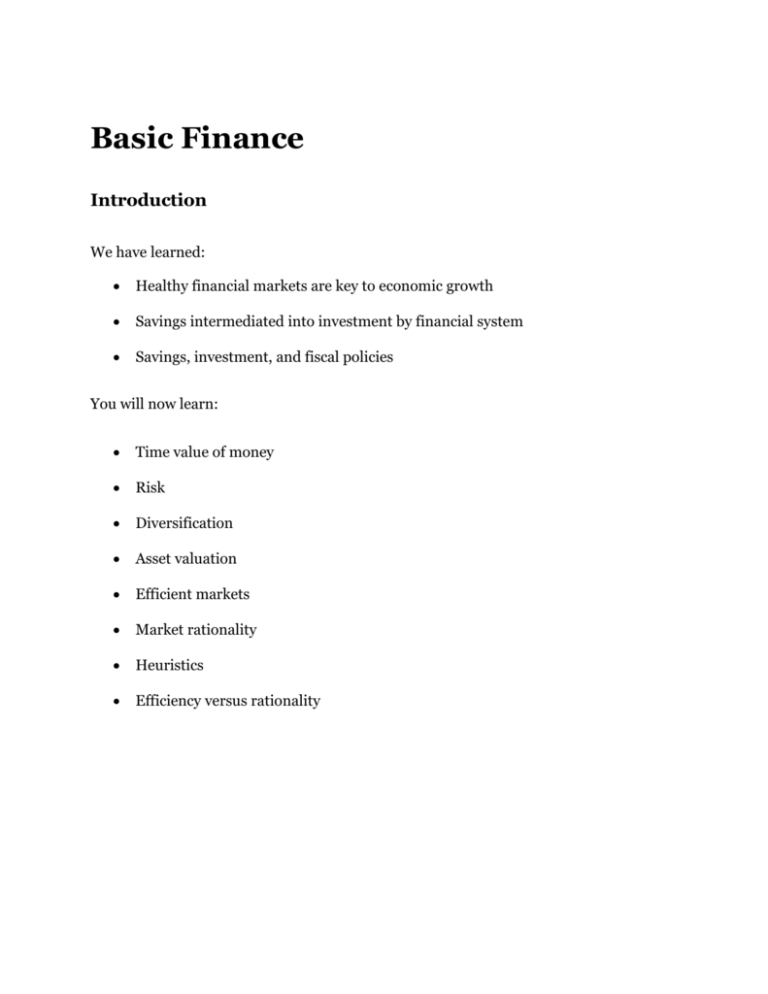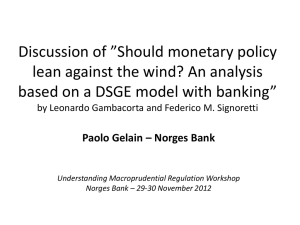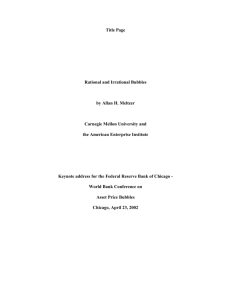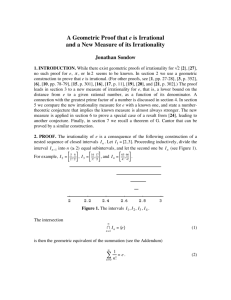Ch 19 Basic Finance
advertisement

Basic Finance Introduction We have learned: Healthy financial markets are key to economic growth Savings intermediated into investment by financial system Savings, investment, and fiscal policies You will now learn: Time value of money Risk Diversification Asset valuation Efficient markets Market rationality Heuristics Efficiency versus rationality Time Value of Money Definition: finance is about decision making regarding allocation or resources over time, considering risk Money today is more valuable than money tomorrow $100 offer, today or one year from now o Risks default inflation o alternative use (opportunity cost) o pure time value = interest rates to compensate Future Value Simple: $100 @ 5% interest for 3 years= 100*1.05^3=115.76 Compound $100 @ 5% interest for 3 years compounded quarterly= 116.08 Compound > Simple Magic of compound interest: TVM Application Present value Promised $100 two years from now when you could earn 7% interest= $87.34 Net Present Value 𝒏 𝑵𝑷𝑽 = ∑ 𝒊=𝟏 𝒄𝒂𝒔𝒉 𝒇𝒍𝒐𝒘𝒔 (𝟏 + 𝒅𝒊𝒔𝒄𝒐𝒖𝒏𝒕 𝒓𝒂𝒕𝒆)𝒊 Financial decision-making tool/ decision rule NPV>0 o Example: would you pay $100 for a money machine that spit out $40/year for 3 years (assume 10% =r) o TVM Application Accounts for risk, opportunity cost (by discounting CFs) when comparing costs v. benefits RISK Risk equals uncertainty o Measured by variance, which is a measure of dispersion Definition of utility: Marginal utility diminishes: the more wealth that a person has, the less utility he gets from an additional $ o Means that losing $100 is more painful than gaining $100 is pleasurable Risk can’t really be eliminated, but it can be minimized….HOW? Buy insurance Diversify Sacrifice return Insurance: indemnification against loss in the event of specified contingencies o Insurance works by creating pools and spreading risk o Cancer insurance example o Never profit from insurance, indemnify means “to make whole” Adverse selection: o high risk people are more likely to buy insurance o insurers know this; so they (price) discriminate o try to reduce risk in pool (kick sick guys out or keep them out) moral hazard o increased risk exposure due to the fact that insurance has removed/reduced incentive to be careful o rental car insurance example o financial crisis example Diversification Do not put all of your eggs in one basket Except for home (or insured assets), no more than 5% in any single asset Diversification: risk reduction achieved by drowning risky asset in a pool of unrelated risks Place a large number of small bets instead of a small number of large bets Portfolio diversification Portfolio is a collection of assets, such as stocks (ownership of a corporation) Standard deviation is measure of volatility (riskiness) of a variable Increased sigma equals increased risk Portfolio risk decreases with the inclusion of more assets Impossible to eliminate all risk, but firm-specific risk can be practically eliminated Firm-specific risk Market risk Stock investing example correlation 2 US auto companies- across firms US Auto + Toyota- across countries Auto company + restaurants- across sectors Stock plus bond- across asset types Buy a mutual fund or ETF, etc. When diversifying, risk is going down but so is return: that’s the price you pay for safety it’s like buying insurance various financial instruments designed to mitigate investment risk options short sales hedge funds futures contracts exotic derivatives Some assets are safer than others: 1950-present (source: FRED) Treasuries Stocks (sp500) Nominal Return (annual) Risk 4.67% 7% 2.99% 14% Asset Valuation Price of a share of stock is a function of supply and demand Fundamental Analysis: the study of a firm’s financial statements, competitive environment, and all other info about firm to determine value o Price<value = undervalued o Price>value = overvalued o Price=value=fair value Share value: present value of future dividend/income stream o Related to profitability of firm, which is a highly complex function Three ways to rely on fundamental analysis o Do the research o Rely on analysts o Mutual fund Efficient Markets Whereas well-functioning markets are the basis for the performance of a capitalist society, great attention has been focused on the efficiency of markets Efficiency: market prices reflect all available public information about the asset; and, o New information is quickly impounded into the price If some information is not priced, then the price is “wrong” Investors search for information and change price Sluggish price movements can lead to serious misallocation of resources o Example: cell phones overpriced, leads to waste on phones and lack of??? (You never see what didn’t happen) Price changes follow a random walk Impossible to earn abnormal profits from publicly available information o Warren Buffet and a few others do the impossible o Professional money managers fail to consistently beat the market Examples: o DPRK nuclear tests and S.K. stock price declines o 9/11 o CEO death o Takeover Market Rationality EMH assumes that all public information is processed by rational actors o What about irrationality? o What about behavioral biases? o The madness of crowds Keynes suggested that asset prices driven by animal spirits o Example: beauty contest Bubbles Tulipmania: Roaring 20’s followed by ’29 Crash Dot.com bubble in the 1990s Real Estate bubble in 2000s o Bubbles are evidence of the irrationality of markets, of the effects of behavioural biases and the madness of crowds Experiments have shown that psychology matters o Example: Stock trading and the power of a woman’s touch Behavioural finance is the study of the influence of psychology on the behaviour of financial practitioners and the subsequent effect on markets. Heuristics o Disposition effect: investors sell winners too soon and hang on to losers Loss aversion: the psychological impact of loss is greater than impact of win o Status quo bias o Money illusion: confusing nominal returns/wages with real returns/wages o Monte Carlo Fallacy: deviations from expected outcome in repeated independent trials of a random process, future deviations in opposite direction (bunch of tails means heads is next) short sequences of random events should be representative of longer ones o Attachment bias: long term relationships with investments because of psychological attachment o Overconfidence: e.g., ignoring fat tails Framing: Social Science def: use of anecdotes, stereotypes, and other specific characteristics of presentation to make judgment, instead of rational choice; Behavioral finance def: framing means that the way a person subjectively frames a transaction in their mind will determine the utility they receive or expect. o Anchoring: placing too much emphasis on certain information while discounting other information Tversky and Kahneman showed that when asked to guess the percentage of African nations that are members of the United Nations, people who were first asked "Was it more or less than 10%?" guessed lower values (25% on average) than those who had been asked if it was more or less than 65% (45% on average) Imagine that the U.S. is preparing for the outbreak of an unusual Asian disease, which is expected to kill 600 people. Two alternative programs to combat the disease have been proposed. Assume the exact scientific estimate of the consequences of the programs are as follows." In a group of 600 people, Program A: "200 people will be saved" Program B: "there is a one-third probability that 600 people will be saved, and a two-thirds probability that no people will be saved" Program C: "400 people will die" Program D: "there is a one-third probability that nobody will die, and a two-third probability that 600 people will die Ending Emphasis: 60% return on investment, then lose 10% before selling at 50% gain o Because last action was a slide, psychological loser Extrapolation bias: future equals recent past Equity Premium Puzzle: equity premium way too high; implies much higher risk aversion levels than are reasonable o Stocks payoff “too much” for rational theory to explain Herding: managers can’t get in trouble for losing money on stock that every other manager also holds, but if he goes long on a flyer and it dumps on him, then he’s toast (or so he perceives); so he follows the crowd Efficiency versus Irrationality Efficiency: market prices reflect all public information, rational market participants If market is inefficient, this is an argument for the government to step in o Improve outcome or worsen outcome? If you think that you have found market inefficiency, you’d be rich; then, inefficiency would get traded away Is Warren Buffet just lucky? Doesn’t financial crisis prove that market is inefficient? o No one saw it coming (Roubini, Paulsen) o Efficiency doesn’t equal perfect o Sometimes, the rational thing to do is go with the mad crowd (follow irrational bubble and try to get out at right time; which makes the bubble worse, by the way) o What information wasn’t impounded into prices before the crisis? Irrational actors cancel each other out Government run by irrational actors with behavioral biases, so how can the government really fix markets o Regulators are regularly blamed for failure to prevent crisis If you think that stock market is efficient, you don’t have to research any firms because all information is already reflected into price o Index funds generally outperform actively managed funds Strongest evidence for market efficiency











